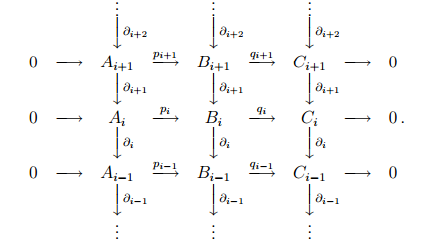


 تاريخ الرياضيات
تاريخ الرياضيات
 الرياضيات في الحضارات المختلفة
الرياضيات في الحضارات المختلفة 
 الرياضيات المتقطعة
الرياضيات المتقطعة
 الجبر
الجبر
 الهندسة
الهندسة 
 المعادلات التفاضلية و التكاملية
المعادلات التفاضلية و التكاملية 
 التحليل
التحليل
 علماء الرياضيات
علماء الرياضيات |
Read More
Date: 28-7-2021
Date: 10-6-2021
Date: 4-7-2017
|
Definition A chain complex C∗ is a (doubly infinite) sequence (Ci: i ∈ Z) of modules over some unital ring, together with homomorphisms ∂I : Ci → Ci−1 for each i ∈ Z, such that ∂i ◦ ∂i+1 = 0 for all integers i.
The ith homology group Hi(C∗) of the complex C∗ is defined to be the quotient group Zi(C∗)/Bi(C∗), where Zi(C∗) is the kernel of ∂i: Ci → Ci−1 and Bi(C∗) is the image of ∂i+1: Ci+1 → Ci .
Note that if the modules C∗ occuring in a chain complex C∗ are modules over some unital ring R then the homology groups of the complex are also modules over this ring R.
Definition Let C∗ and D∗ be chain complexes. A chain map f: C∗ → D∗ isa sequence fi: Ci → Di of homomorphisms which satisfy the commutativity condition ∂i ◦ fi = fi−1 ◦ ∂ifor all i ∈ Z.
Note that a collection of homomorphisms fi : Ci → Di defines a chain map f∗: C∗ → D∗ if and only if the diagram

is commutative.
Let C∗ and D∗ be chain complexes, and let f∗: C∗ → D∗ be a chain map.
Then fi(Zi(C∗)) ⊂ Zi(D∗) and fi(Bi(C∗)) ⊂ Bi(D∗) for all i. It follows from this that fi : Ci → Di induces a homomorphism f∗: Hi(C∗) → Hi(D∗) of homology groups sending [z] to [fi(z)] for all z ∈ Zi(C∗), where [z] = z + Bi(C∗), and [fi(z)] = fi(z) + Bi(D∗).
Definition A short exact sequence 0−→A∗ p∗→B∗ q∗→C∗→0 of chain complexes consists of chain complexes A∗, B∗ and C∗ and chain maps p∗: A∗ → B∗ and q∗: B∗ → C∗ such that the sequence
0→Ai pi →Bi qi→Ci→0
is exact for each integer i.
We see that 0→A∗p∗ −→B∗q∗→C∗→0 is a short exact sequence of chain complexes if and only if the diagram

Lemma 1.1 Given any short exact sequence 0→A∗p∗→B∗q∗→C∗→0 of chain complexes, there is a well-defined homomorphism
αi: Hi(C∗) → Hi−1(A∗)
which sends the homology class [z] of z ∈ Zi(C∗) to the homology class [w] of any element w of Zi−1(A∗) with the property that pi−1(w) = ∂i(b) for some b ∈ Bi satisfying qi(b) = z.
Proof Let z ∈ Zi(C∗). Then there exists b ∈ Bi satisfying qi(b) = z, since
qi: Bi → Ci is surjective. Moreover
qi−1(∂i(b)) = ∂i(qi(b)) = ∂i(z) = 0.
But pi−1: Ai−1 → Bi−1 is injective and pi−1(Ai−1) = ker qi−1, since the sequence
0−→Ai−1 pi−1−→Bi−1 qi−1→Ci−1
is exact. Therefore there exists a unique element w of Ai−1 such that ∂i(b) =pi−1(w). Moreover
pi−2(∂i−1(w)) = ∂i−1(pi−1(w)) = ∂i−1(∂i(b)) = 0
(since ∂i−1 ◦ ∂i = 0), and therefore ∂i−1(w) = 0 (since pi−2: Ai−2 → Bi−2 is injective). Thus w ∈ Zi−1(A∗).



|
|
|
|
التوتر والسرطان.. علماء يحذرون من "صلة خطيرة"
|
|
|
|
|
|
|
مرآة السيارة: مدى دقة عكسها للصورة الصحيحة
|
|
|
|
|
|
|
العتبة العباسية المقدسة تُطلق فعّاليات مؤتمر ذاكرة الألم في العراق
|
|
|